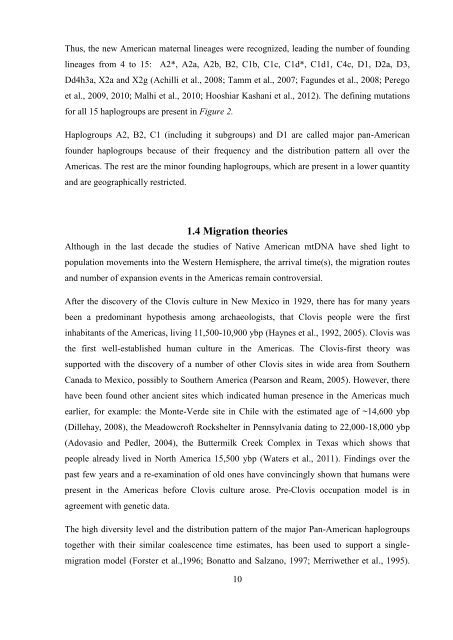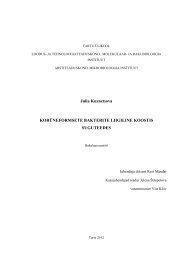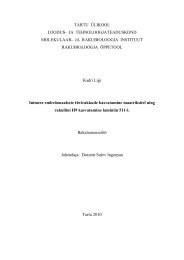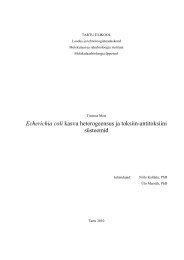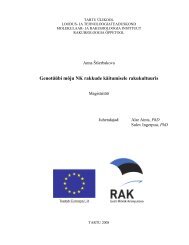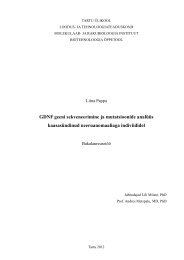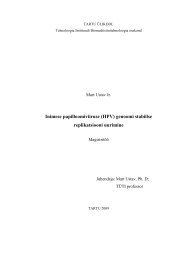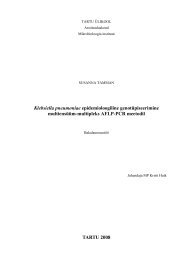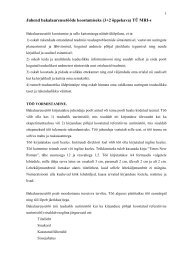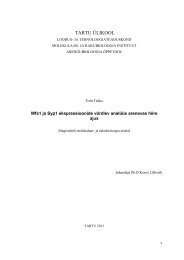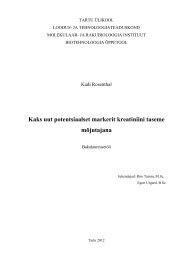Maternal variation in Huichol and Mixtec populations from Mexico
Maternal variation in Huichol and Mixtec populations from Mexico
Maternal variation in Huichol and Mixtec populations from Mexico
Create successful ePaper yourself
Turn your PDF publications into a flip-book with our unique Google optimized e-Paper software.
Thus, the new American maternal l<strong>in</strong>eages were recognized, lead<strong>in</strong>g the number of found<strong>in</strong>g<br />
l<strong>in</strong>eages <strong>from</strong> 4 to 15: A2*, A2a, A2b, B2, C1b, C1c, C1d*, C1d1, C4c, D1, D2a, D3,<br />
Dd4h3a, X2a <strong>and</strong> X2g (Achilli et al., 2008; Tamm et al., 2007; Fagundes et al., 2008; Perego<br />
et al., 2009, 2010; Malhi et al., 2010; Hooshiar Kashani et al., 2012). The def<strong>in</strong><strong>in</strong>g mutations<br />
for all 15 haplogroups are present <strong>in</strong> Figure 2.<br />
Haplogroups A2, B2, C1 (<strong>in</strong>clud<strong>in</strong>g it subgroups) <strong>and</strong> D1 are called major pan-American<br />
founder haplogroups because of their frequency <strong>and</strong> the distribution pattern all over the<br />
Americas. The rest are the m<strong>in</strong>or found<strong>in</strong>g haplogroups, which are present <strong>in</strong> a lower quantity<br />
<strong>and</strong> are geographically restricted.<br />
1.4 Migration theories<br />
Although <strong>in</strong> the last decade the studies of Native American mtDNA have shed light to<br />
population movements <strong>in</strong>to the Western Hemisphere, the arrival time(s), the migration routes<br />
<strong>and</strong> number of expansion events <strong>in</strong> the Americas rema<strong>in</strong> controversial.<br />
After the discovery of the Clovis culture <strong>in</strong> New <strong>Mexico</strong> <strong>in</strong> 1929, there has for many years<br />
been a predom<strong>in</strong>ant hypothesis among archaeologists, that Clovis people were the first<br />
<strong>in</strong>habitants of the Americas, liv<strong>in</strong>g 11,500-10,900 ybp (Haynes et al., 1992, 2005). Clovis was<br />
the first well-established human culture <strong>in</strong> the Americas. The Clovis-first theory was<br />
supported with the discovery of a number of other Clovis sites <strong>in</strong> wide area <strong>from</strong> Southern<br />
Canada to <strong>Mexico</strong>, possibly to Southern America (Pearson <strong>and</strong> Ream, 2005). However, there<br />
have been found other ancient sites which <strong>in</strong>dicated human presence <strong>in</strong> the Americas much<br />
earlier, for example: the Monte-Verde site <strong>in</strong> Chile with the estimated age of ~14,600 ybp<br />
(Dillehay, 2008), the Meadowcroft Rockshelter <strong>in</strong> Pennsylvania dat<strong>in</strong>g to 22,000-18,000 ybp<br />
(Adovasio <strong>and</strong> Pedler, 2004), the Buttermilk Creek Complex <strong>in</strong> Texas which shows that<br />
people already lived <strong>in</strong> North America 15,500 ybp (Waters et al., 2011). F<strong>in</strong>d<strong>in</strong>gs over the<br />
past few years <strong>and</strong> a re-exam<strong>in</strong>ation of old ones have conv<strong>in</strong>c<strong>in</strong>gly shown that humans were<br />
present <strong>in</strong> the Americas before Clovis culture arose. Pre-Clovis occupation model is <strong>in</strong><br />
agreement with genetic data.<br />
The high diversity level <strong>and</strong> the distribution pattern of the major Pan-American haplogroups<br />
together with their similar coalescence time estimates, has been used to support a s<strong>in</strong>glemigration<br />
model (Forster et al.,1996; Bonatto <strong>and</strong> Salzano, 1997; Merriwether et al., 1995).<br />
10


